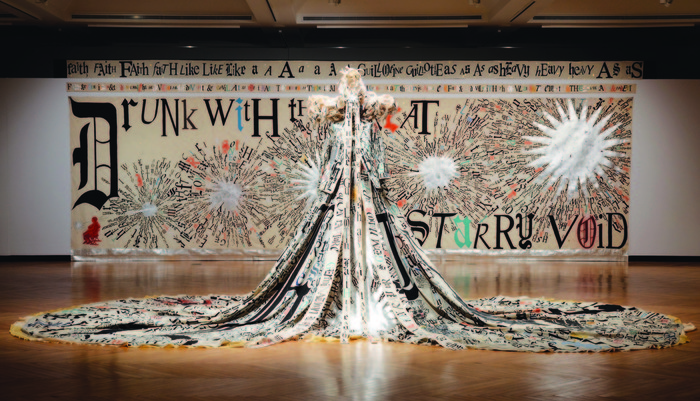Arts and Letters: Lesley Dill in Conversation
By Lee Ann Norman
March 2015, Brooklyn, NY: Lesley Dill works in sculpture, photography, and performance, using a range of media and methods to explore themes of language, the body, and what it means to be transformed by an experience. She recently participated in Beautiful Beast at the New York Academy of Art, an exhibition that explored the intersection of beauty and abjection through sculpture, often depicting our humanity through distortion. I am always interested in work that defies disciplinary boundaries and convention, and Dill's keen fondness for words drove my curiosity about her work even more. I met with the artist at her home and studio in downtown Brooklyn recently where we discussed representations of the feminine and masculine in culture, mentorship in the art world, faith, and of course words.
Lesley Dill: Over the years I’ve made dress forms in various materials—paper, fabric, metal. I don’t think of the dress image as sentimental or pretty. It is a shape. I love Martin Puryear’s dedication to form. In my dress sculptures, I compress the bodice into fragility and open the skirt wide. The delicacy of the top invites intimacy, but defies familiarity because the expansion of the edge creates a boundary.
What changed my thoughts about gender presentation was when [my husband] Ed got a job in New Delhi in 1990, and I went with him. In New York we sculptors wore jeans, tight black t-shirts and work boots. In India, no one dressed like that—even the women who broke rocks for highways wore skirts. My friends who were lawyers and doctors wore either saris or salwar kameez. The look was very, very feminine. We lived there for two years, and that’s when I really began to associate femininity with power.
Lee Ann Norman: I don’t think we have that same sensibility here.
LD: No. Since living there, I’ve stopped wearing pants and only wear dresses. I was so influenced by that time in India. The interest in femininity and forcefulness is something that lasted for me.
LAN: Can you tell me a little more about words as armor, how that came into being when you started making the dress forms and adding words? It’s making me think of Islamic art where so much of it is based in calligraphy because to make an image of God would be considered blasphemous.
LD: Muslim warriors in the 18th century would go into battle and have a prayer to Allah engraved on their armor, and thus be protected by an amulet of words. Historically, there’s not been much protective armor for women. So what does that mean? Are we not battle heroes to be protected? Think of the woman character [Brienne of Tarth] in the TV series Game of Thrones—she’s fantastic—big and strong, and she’s armored, yet still a girl. My metal linguistic dresses are perforated with solids of metal words and spaces where they are wired together. Clothing, like language, selectively conceals and reveals.
Read More at artslant.com >> Image : Big Gal Faith, Installation view from Faith & the Devil, Traveling Exhibition [emphasis added]



